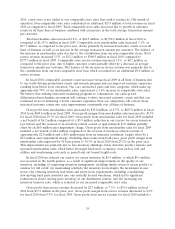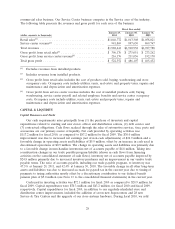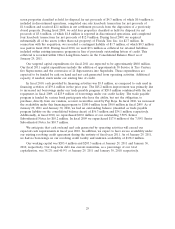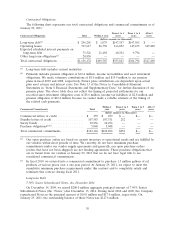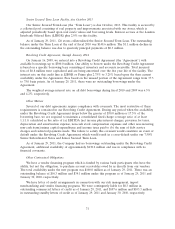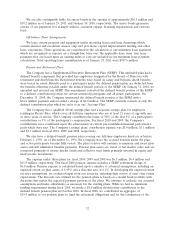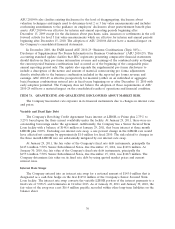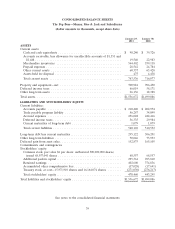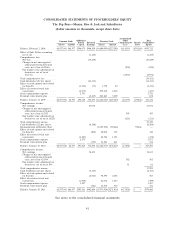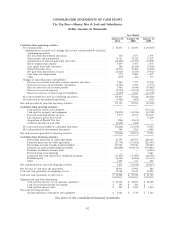Pep Boys 2010 Annual Report Download - page 91
Download and view the complete annual report
Please find page 91 of the 2010 Pep Boys annual report below. You can navigate through the pages in the report by either clicking on the pages listed below, or by using the keyword search tool below to find specific information within the annual report.defined benefit portion of the SERP. Based upon the current status of the plans, we do not expect to
make any cash contributions in fiscal 2011. See Note 13 of Notes to Consolidated Financial Statements
in ‘‘Item 8 Financial Statements and Supplementary Data’’ for further discussion of our pension plans.
CRITICAL ACCOUNTING POLICIES AND ESTIMATES
Management’s Discussion and Analysis of Financial Condition and Results of Operations discusses
our consolidated financial statements, which have been prepared in accordance with accounting
principles generally accepted in the United States of America. The preparation of these financial
statements requires management to make estimates and assumptions that affect the reported amounts
of assets and liabilities, the disclosure of contingent assets and liabilities at the date of the consolidated
financial statements and the amounts of revenues and expenses during the reporting period. On an
on-going basis, management evaluates its estimates and judgments, including those related to customer
incentives, product returns and warranty obligations, bad debts, inventories, income taxes, financing
operations, restructuring costs, retirement benefits, share-based compensation, risk participation
agreements, contingencies and litigation. Management bases its estimates and judgments on historical
experience and on various other factors that are believed to be reasonable under the circumstances, the
results of which form the basis for making judgments about the carrying values of assets and liabilities
that are not readily apparent from other sources. Actual results may differ from these estimates under
different assumptions or conditions.
We believe that the following represent our more critical estimates and assumptions used in the
preparation of the consolidated financial statements:
• Inventory is stated at lower of cost, as determined under the last-in, first-out (LIFO) method, or
market. Our inventory, consisting primarily of auto parts and accessories, is used on vehicles
typically having longer lives. Because of this, along with our historical experience of returning
most excess inventory to our vendors for full credit, the risk of obsolescence is minimal. We
establish a reserve for excess inventory for instances where less than full credit will be received
for such returns and where we anticipate items will be sold at retail prices that are less than
recorded costs. The reserve is based on management’s judgment, including estimates and
assumptions regarding marketability of products, the market value of inventory to be sold in
future periods and on historical experiences where we received less than full credit from vendors
for product returns.
In fiscal 2010, we reduced our reserve for excess inventory by $5.9 million to $5.4 million from
$11.3 million primarily due to improvement in inventory management practices, including timely
return of product to vendors for full credit. However, in future periods we may be exposed to
material losses should our vendors alter their policy with regard to accepting excess inventory
returns.
A 10% difference in our inventory reserves as of January 29 2011, would have affected net
income by approximately $0.3 million in fiscal 2010.
• We record reserves for future sales returns, customer incentives, warranty claims and inventory
shrinkage. The reserves are based on expected returns of products and historical claims and
inventory shrinkage experience. If actual experience differs from historical levels, revisions in our
estimates may be required. A 10% change in these reserves at January 29, 2011 would have
affected net earnings by approximately $0.8 million for fiscal 2010.
• We have risk participation arrangements with respect to workers’ compensation, general liability,
automobile liability, other casualty coverages and health care insurance, including stop loss
coverage with third party insurers to limit our total exposure. A reserve for the liabilities
associated with these agreements is established using generally accepted actuarial methods
33



